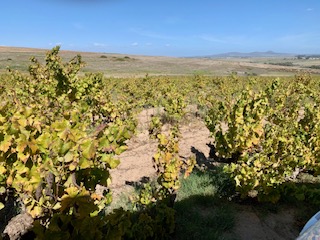Old Vine Project update
Like the vines themselves, the Old Vine Project is far from static; statistics are kept updated, as is the website (oldvineproject.co.za); new information and expertise ensure the heritage vines receive the best possible care for their well-being and future crops.
Statistics can also tell a story beyond the numbers, as they do in how hectares, variety and area, vines 35 years and older have expanded since 2018. Perhaps more significant than the total area (up from 3,505ha in 2018 to 4,292ha in 2022), are the varieties that make up the majority of that area and recorded the highest increase over the same period.
No surprise that Chenin Blanc heads the list both in area, 2,207.03ha an increase of 371.23ha. If wine lovers prefer their Sauvignon Blancs young, the vines are much prized with age; there are now 453.59ha over 35, an increase of 140.81ha on 2018. The oldest Sauvignon vineyard (pictured), on the Swartland farm, Klein Amoskuil, was planted in 1965.
Surprises? Crouchen (previously Cape Riesling) covers just short of 132ha, of that 63.06ha qualify as old vines and that is an increase of 23.44ha on 2018. For a variety that was thought of by many as a pariah, there are obviously some who appreciate it.
A welcome surprise is that classics, such as Riesling and Pinot Noir, have also increased their old vine base; Riesling now totals 34.78ha and Pinot at 18.48ha. Especially in Robertson, where much Pinot is used for Cap Classique production, there’s been considerable increase.
As might be expected, Stellenbosch heads the charts of old vine area with just over 1,014ha. At the other extreme, Central Orange River has jumped from no old vines in 2018 to the current 62.41ha.
If these figures demonstrate nothing else, it’s that winegrowers and winemakers are becoming more aware of the benefit of old vines and the Old Vine Project.
Chatting to Rosa Kruger, who started the whole movement when she first went searching for old vines in 2002, she mentioned; “There is great renewed interest in growing and the viticulture of old vines, not only by those with small farms; a farmer with many hectares, who had been a little negative about old vines, made some Chenin from tiny bunches on long-unpruned vines due to be uprooted. The wine was so good, he’s now keeping a few old vineyards and has joined the OVP.”
Experience has taught her that age doesn’t necessarily determine how vines recently turned 35 will do. “I’ve seen some 100 year old vines doing better than the younger oldies. Soil health, rainfall, farming practices etc, are more important.”
Since farmers have been made aware that the correct pruning of old vines is crucial to their health, many are following the OVP guidelines; “this has made a huge difference in restoring life to the vines,” Rosa acknowledges. “Always promote and prune to the healthy wood where the sap flow is stronger and the vine shows where it wants to grow.”
The OVP runs winter pruning schools, where workers receive instructions about pruning old vines and vines generally. Rosa also personally trains workers on the farms she consults to and visits daily.
The Old Vine Project not only gives impetus to retaining old vines that can produce great wine but training vineyard workers to prune and care for them, so increasing their experience and helping to raise their self-esteem.

Top: SA's oldest Sauvignon Blanc vineyard, planted in 1965
Blog by Angela Lloyd